South University: PSY4570 Annotated Bibliography on Mood Disorders
VerifiedAdded on 2022/09/15
|9
|1911
|15
Annotated Bibliography
AI Summary
This annotated bibliography examines the impact of mood disorders on various aspects of life, including work, home, and relationships, compiling six peer-reviewed journal articles published within the last five years. The articles explore a range of topics, such as the effectiveness of treatments for mood disorders in children, cognitive impairment in bipolar disorder among older adults, the long-term effects of mental disorders on employment, the relationship between bipolar disorder and other psychiatric disorders, gender disparities in mood disorders, and the impact of cognitive dysfunction on functional outcomes in bipolar disorder. Each entry provides a concise summary of the article's purpose, major points, methods, results, and conclusions, followed by an analysis of the article's strengths, weaknesses, and relevance to the broader topic. The bibliography highlights the complex interplay between mood disorders and various life domains, providing a valuable resource for understanding the multifaceted challenges faced by individuals with these conditions. The research emphasizes the importance of considering both biological and psychosocial factors in the treatment and management of mood disorders and addressing the broader societal implications of these conditions.
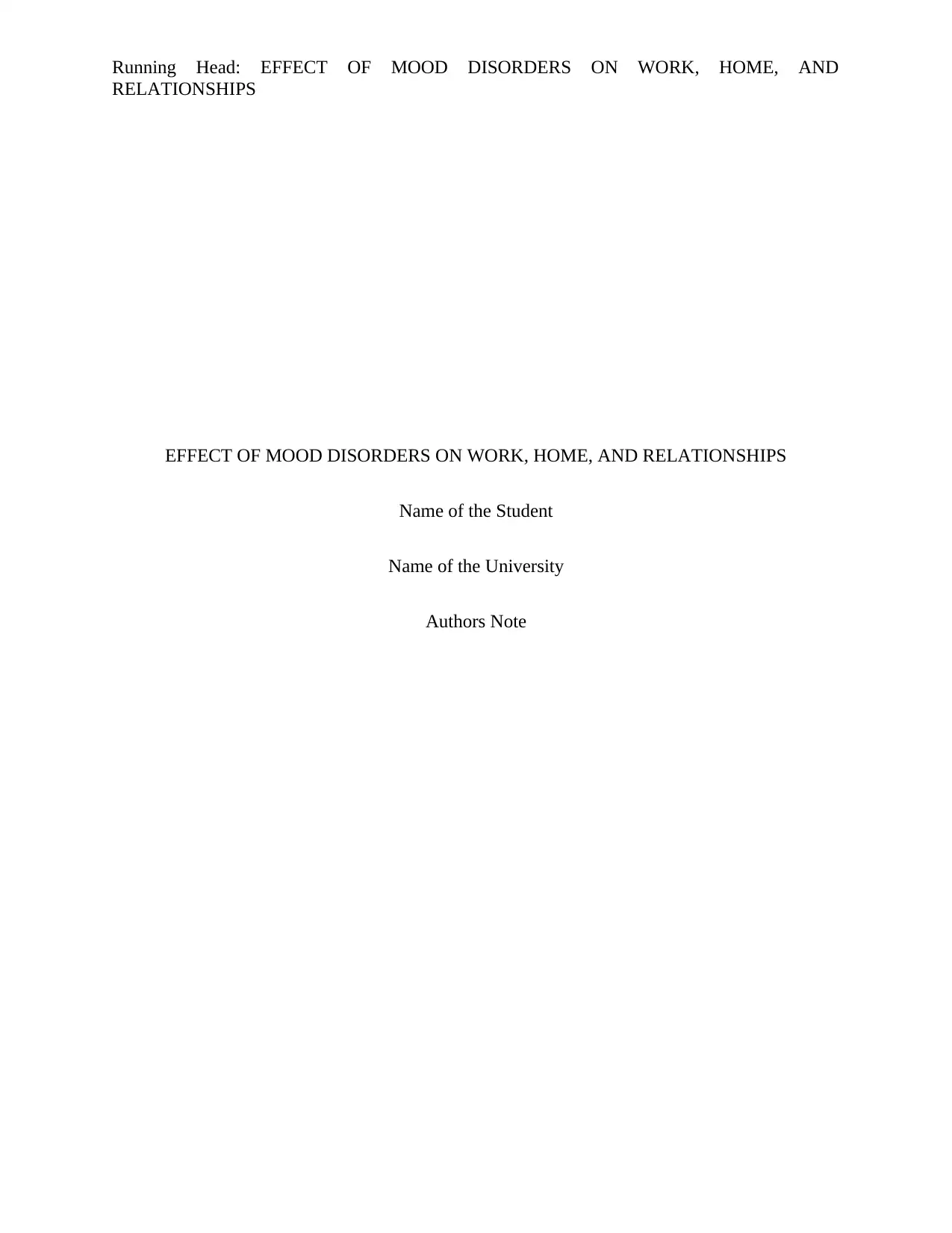
Running Head: EFFECT OF MOOD DISORDERS ON WORK, HOME, AND
RELATIONSHIPS
EFFECT OF MOOD DISORDERS ON WORK, HOME, AND RELATIONSHIPS
Name of the Student
Name of the University
Authors Note
RELATIONSHIPS
EFFECT OF MOOD DISORDERS ON WORK, HOME, AND RELATIONSHIPS
Name of the Student
Name of the University
Authors Note
Paraphrase This Document
Need a fresh take? Get an instant paraphrase of this document with our AI Paraphraser
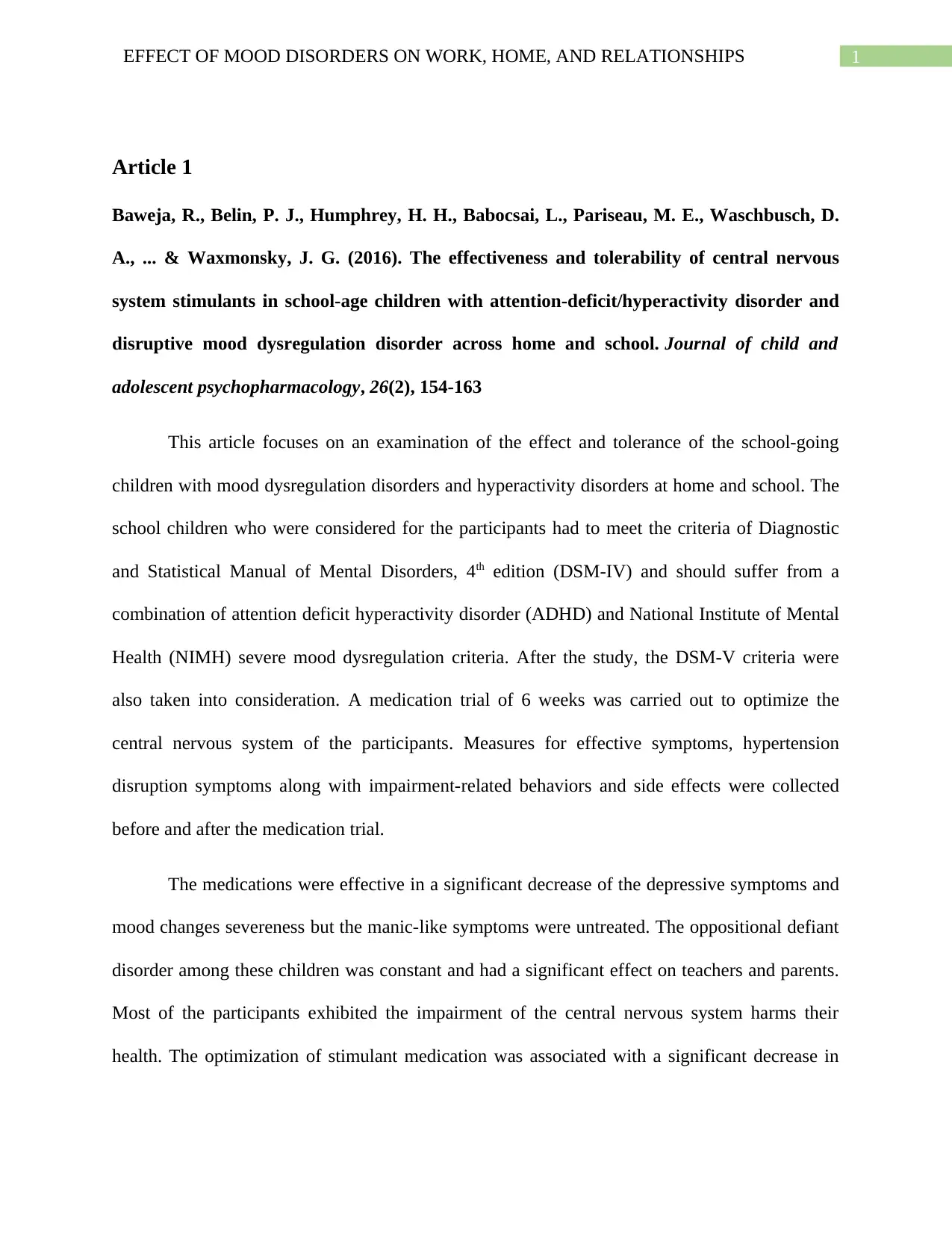
1EFFECT OF MOOD DISORDERS ON WORK, HOME, AND RELATIONSHIPS
Article 1
Baweja, R., Belin, P. J., Humphrey, H. H., Babocsai, L., Pariseau, M. E., Waschbusch, D.
A., ... & Waxmonsky, J. G. (2016). The effectiveness and tolerability of central nervous
system stimulants in school-age children with attention-deficit/hyperactivity disorder and
disruptive mood dysregulation disorder across home and school. Journal of child and
adolescent psychopharmacology, 26(2), 154-163
This article focuses on an examination of the effect and tolerance of the school-going
children with mood dysregulation disorders and hyperactivity disorders at home and school. The
school children who were considered for the participants had to meet the criteria of Diagnostic
and Statistical Manual of Mental Disorders, 4th edition (DSM-IV) and should suffer from a
combination of attention deficit hyperactivity disorder (ADHD) and National Institute of Mental
Health (NIMH) severe mood dysregulation criteria. After the study, the DSM-V criteria were
also taken into consideration. A medication trial of 6 weeks was carried out to optimize the
central nervous system of the participants. Measures for effective symptoms, hypertension
disruption symptoms along with impairment-related behaviors and side effects were collected
before and after the medication trial.
The medications were effective in a significant decrease of the depressive symptoms and
mood changes severeness but the manic-like symptoms were untreated. The oppositional defiant
disorder among these children was constant and had a significant effect on teachers and parents.
Most of the participants exhibited the impairment of the central nervous system harms their
health. The optimization of stimulant medication was associated with a significant decrease in
Article 1
Baweja, R., Belin, P. J., Humphrey, H. H., Babocsai, L., Pariseau, M. E., Waschbusch, D.
A., ... & Waxmonsky, J. G. (2016). The effectiveness and tolerability of central nervous
system stimulants in school-age children with attention-deficit/hyperactivity disorder and
disruptive mood dysregulation disorder across home and school. Journal of child and
adolescent psychopharmacology, 26(2), 154-163
This article focuses on an examination of the effect and tolerance of the school-going
children with mood dysregulation disorders and hyperactivity disorders at home and school. The
school children who were considered for the participants had to meet the criteria of Diagnostic
and Statistical Manual of Mental Disorders, 4th edition (DSM-IV) and should suffer from a
combination of attention deficit hyperactivity disorder (ADHD) and National Institute of Mental
Health (NIMH) severe mood dysregulation criteria. After the study, the DSM-V criteria were
also taken into consideration. A medication trial of 6 weeks was carried out to optimize the
central nervous system of the participants. Measures for effective symptoms, hypertension
disruption symptoms along with impairment-related behaviors and side effects were collected
before and after the medication trial.
The medications were effective in a significant decrease of the depressive symptoms and
mood changes severeness but the manic-like symptoms were untreated. The oppositional defiant
disorder among these children was constant and had a significant effect on teachers and parents.
Most of the participants exhibited the impairment of the central nervous system harms their
health. The optimization of stimulant medication was associated with a significant decrease in
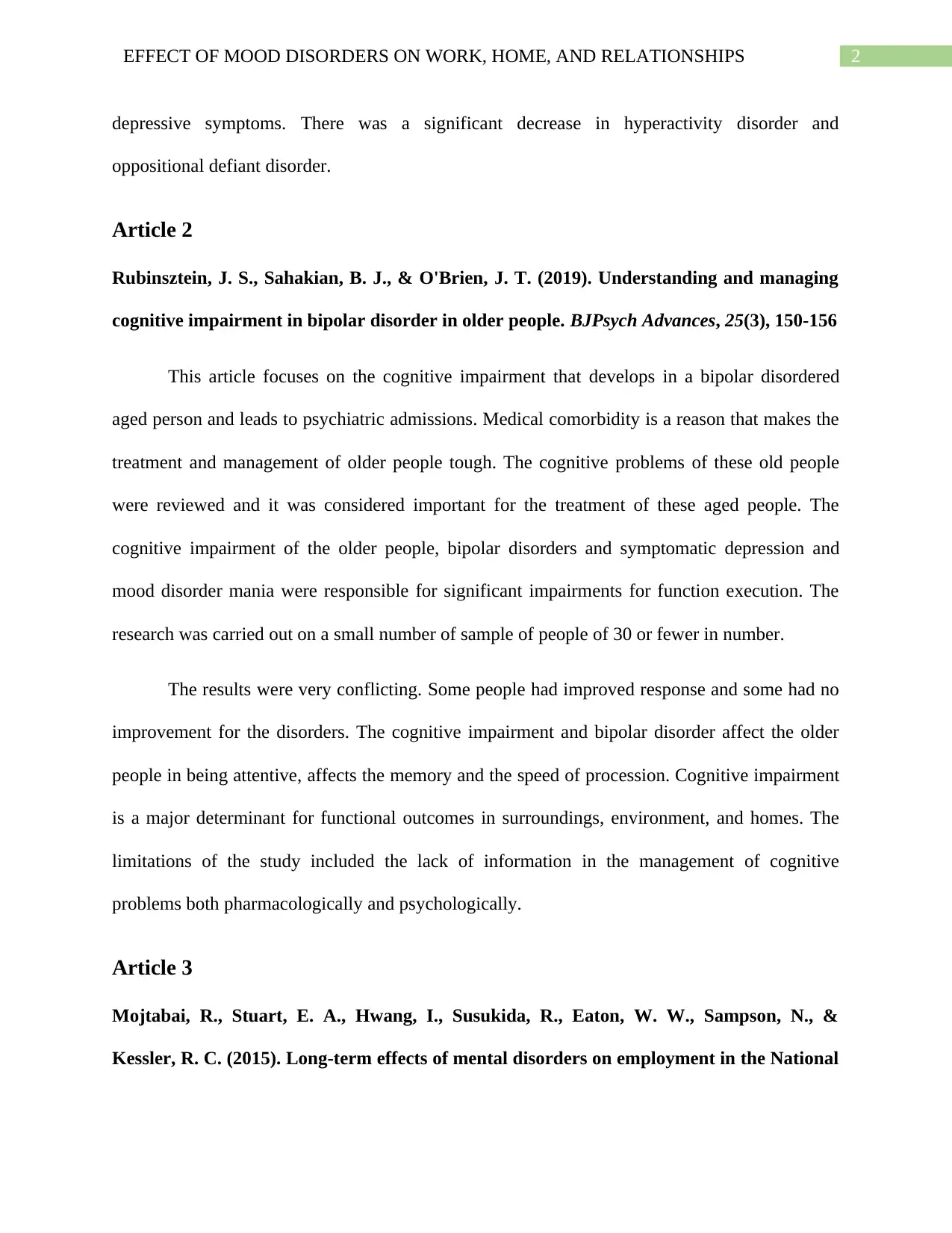
2EFFECT OF MOOD DISORDERS ON WORK, HOME, AND RELATIONSHIPS
depressive symptoms. There was a significant decrease in hyperactivity disorder and
oppositional defiant disorder.
Article 2
Rubinsztein, J. S., Sahakian, B. J., & O'Brien, J. T. (2019). Understanding and managing
cognitive impairment in bipolar disorder in older people. BJPsych Advances, 25(3), 150-156
This article focuses on the cognitive impairment that develops in a bipolar disordered
aged person and leads to psychiatric admissions. Medical comorbidity is a reason that makes the
treatment and management of older people tough. The cognitive problems of these old people
were reviewed and it was considered important for the treatment of these aged people. The
cognitive impairment of the older people, bipolar disorders and symptomatic depression and
mood disorder mania were responsible for significant impairments for function execution. The
research was carried out on a small number of sample of people of 30 or fewer in number.
The results were very conflicting. Some people had improved response and some had no
improvement for the disorders. The cognitive impairment and bipolar disorder affect the older
people in being attentive, affects the memory and the speed of procession. Cognitive impairment
is a major determinant for functional outcomes in surroundings, environment, and homes. The
limitations of the study included the lack of information in the management of cognitive
problems both pharmacologically and psychologically.
Article 3
Mojtabai, R., Stuart, E. A., Hwang, I., Susukida, R., Eaton, W. W., Sampson, N., &
Kessler, R. C. (2015). Long-term effects of mental disorders on employment in the National
depressive symptoms. There was a significant decrease in hyperactivity disorder and
oppositional defiant disorder.
Article 2
Rubinsztein, J. S., Sahakian, B. J., & O'Brien, J. T. (2019). Understanding and managing
cognitive impairment in bipolar disorder in older people. BJPsych Advances, 25(3), 150-156
This article focuses on the cognitive impairment that develops in a bipolar disordered
aged person and leads to psychiatric admissions. Medical comorbidity is a reason that makes the
treatment and management of older people tough. The cognitive problems of these old people
were reviewed and it was considered important for the treatment of these aged people. The
cognitive impairment of the older people, bipolar disorders and symptomatic depression and
mood disorder mania were responsible for significant impairments for function execution. The
research was carried out on a small number of sample of people of 30 or fewer in number.
The results were very conflicting. Some people had improved response and some had no
improvement for the disorders. The cognitive impairment and bipolar disorder affect the older
people in being attentive, affects the memory and the speed of procession. Cognitive impairment
is a major determinant for functional outcomes in surroundings, environment, and homes. The
limitations of the study included the lack of information in the management of cognitive
problems both pharmacologically and psychologically.
Article 3
Mojtabai, R., Stuart, E. A., Hwang, I., Susukida, R., Eaton, W. W., Sampson, N., &
Kessler, R. C. (2015). Long-term effects of mental disorders on employment in the National
⊘ This is a preview!⊘
Do you want full access?
Subscribe today to unlock all pages.

Trusted by 1+ million students worldwide
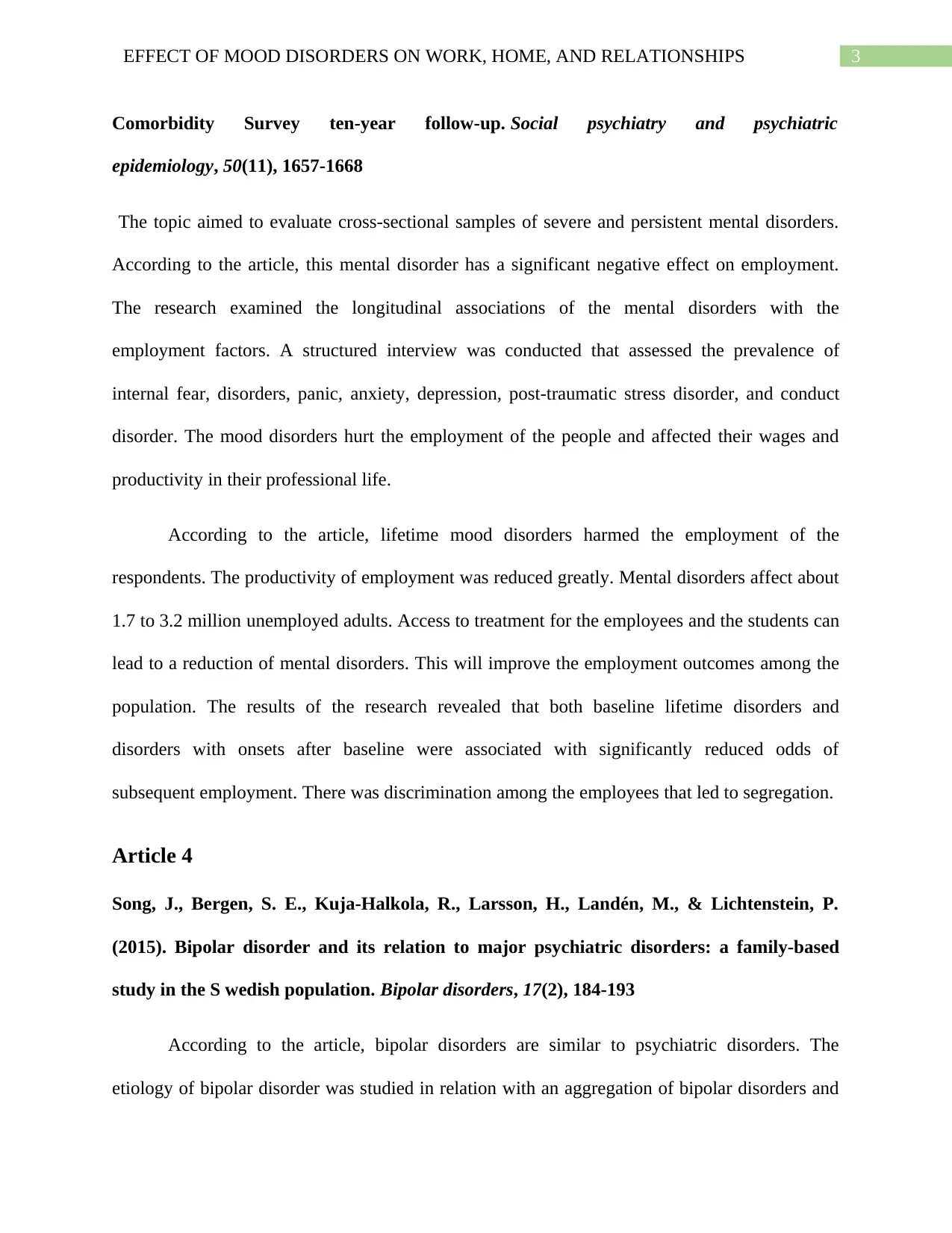
3EFFECT OF MOOD DISORDERS ON WORK, HOME, AND RELATIONSHIPS
Comorbidity Survey ten-year follow-up. Social psychiatry and psychiatric
epidemiology, 50(11), 1657-1668
The topic aimed to evaluate cross-sectional samples of severe and persistent mental disorders.
According to the article, this mental disorder has a significant negative effect on employment.
The research examined the longitudinal associations of the mental disorders with the
employment factors. A structured interview was conducted that assessed the prevalence of
internal fear, disorders, panic, anxiety, depression, post-traumatic stress disorder, and conduct
disorder. The mood disorders hurt the employment of the people and affected their wages and
productivity in their professional life.
According to the article, lifetime mood disorders harmed the employment of the
respondents. The productivity of employment was reduced greatly. Mental disorders affect about
1.7 to 3.2 million unemployed adults. Access to treatment for the employees and the students can
lead to a reduction of mental disorders. This will improve the employment outcomes among the
population. The results of the research revealed that both baseline lifetime disorders and
disorders with onsets after baseline were associated with significantly reduced odds of
subsequent employment. There was discrimination among the employees that led to segregation.
Article 4
Song, J., Bergen, S. E., Kuja‐Halkola, R., Larsson, H., Landén, M., & Lichtenstein, P.
(2015). Bipolar disorder and its relation to major psychiatric disorders: a family‐based
study in the S wedish population. Bipolar disorders, 17(2), 184-193
According to the article, bipolar disorders are similar to psychiatric disorders. The
etiology of bipolar disorder was studied in relation with an aggregation of bipolar disorders and
Comorbidity Survey ten-year follow-up. Social psychiatry and psychiatric
epidemiology, 50(11), 1657-1668
The topic aimed to evaluate cross-sectional samples of severe and persistent mental disorders.
According to the article, this mental disorder has a significant negative effect on employment.
The research examined the longitudinal associations of the mental disorders with the
employment factors. A structured interview was conducted that assessed the prevalence of
internal fear, disorders, panic, anxiety, depression, post-traumatic stress disorder, and conduct
disorder. The mood disorders hurt the employment of the people and affected their wages and
productivity in their professional life.
According to the article, lifetime mood disorders harmed the employment of the
respondents. The productivity of employment was reduced greatly. Mental disorders affect about
1.7 to 3.2 million unemployed adults. Access to treatment for the employees and the students can
lead to a reduction of mental disorders. This will improve the employment outcomes among the
population. The results of the research revealed that both baseline lifetime disorders and
disorders with onsets after baseline were associated with significantly reduced odds of
subsequent employment. There was discrimination among the employees that led to segregation.
Article 4
Song, J., Bergen, S. E., Kuja‐Halkola, R., Larsson, H., Landén, M., & Lichtenstein, P.
(2015). Bipolar disorder and its relation to major psychiatric disorders: a family‐based
study in the S wedish population. Bipolar disorders, 17(2), 184-193
According to the article, bipolar disorders are similar to psychiatric disorders. The
etiology of bipolar disorder was studied in relation with an aggregation of bipolar disorders and
Paraphrase This Document
Need a fresh take? Get an instant paraphrase of this document with our AI Paraphraser
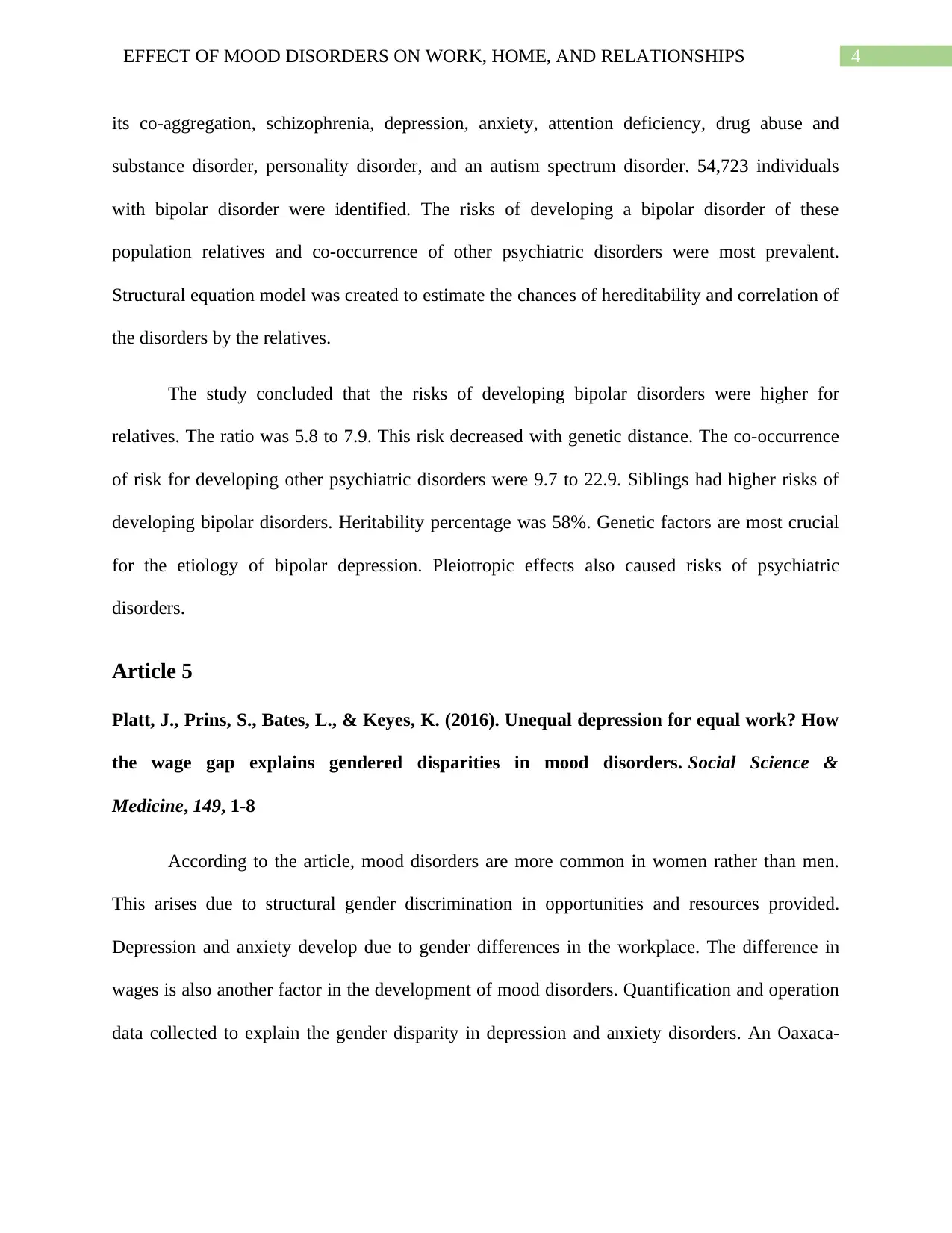
4EFFECT OF MOOD DISORDERS ON WORK, HOME, AND RELATIONSHIPS
its co-aggregation, schizophrenia, depression, anxiety, attention deficiency, drug abuse and
substance disorder, personality disorder, and an autism spectrum disorder. 54,723 individuals
with bipolar disorder were identified. The risks of developing a bipolar disorder of these
population relatives and co-occurrence of other psychiatric disorders were most prevalent.
Structural equation model was created to estimate the chances of hereditability and correlation of
the disorders by the relatives.
The study concluded that the risks of developing bipolar disorders were higher for
relatives. The ratio was 5.8 to 7.9. This risk decreased with genetic distance. The co-occurrence
of risk for developing other psychiatric disorders were 9.7 to 22.9. Siblings had higher risks of
developing bipolar disorders. Heritability percentage was 58%. Genetic factors are most crucial
for the etiology of bipolar depression. Pleiotropic effects also caused risks of psychiatric
disorders.
Article 5
Platt, J., Prins, S., Bates, L., & Keyes, K. (2016). Unequal depression for equal work? How
the wage gap explains gendered disparities in mood disorders. Social Science &
Medicine, 149, 1-8
According to the article, mood disorders are more common in women rather than men.
This arises due to structural gender discrimination in opportunities and resources provided.
Depression and anxiety develop due to gender differences in the workplace. The difference in
wages is also another factor in the development of mood disorders. Quantification and operation
data collected to explain the gender disparity in depression and anxiety disorders. An Oaxaca-
its co-aggregation, schizophrenia, depression, anxiety, attention deficiency, drug abuse and
substance disorder, personality disorder, and an autism spectrum disorder. 54,723 individuals
with bipolar disorder were identified. The risks of developing a bipolar disorder of these
population relatives and co-occurrence of other psychiatric disorders were most prevalent.
Structural equation model was created to estimate the chances of hereditability and correlation of
the disorders by the relatives.
The study concluded that the risks of developing bipolar disorders were higher for
relatives. The ratio was 5.8 to 7.9. This risk decreased with genetic distance. The co-occurrence
of risk for developing other psychiatric disorders were 9.7 to 22.9. Siblings had higher risks of
developing bipolar disorders. Heritability percentage was 58%. Genetic factors are most crucial
for the etiology of bipolar depression. Pleiotropic effects also caused risks of psychiatric
disorders.
Article 5
Platt, J., Prins, S., Bates, L., & Keyes, K. (2016). Unequal depression for equal work? How
the wage gap explains gendered disparities in mood disorders. Social Science &
Medicine, 149, 1-8
According to the article, mood disorders are more common in women rather than men.
This arises due to structural gender discrimination in opportunities and resources provided.
Depression and anxiety develop due to gender differences in the workplace. The difference in
wages is also another factor in the development of mood disorders. Quantification and operation
data collected to explain the gender disparity in depression and anxiety disorders. An Oaxaca-
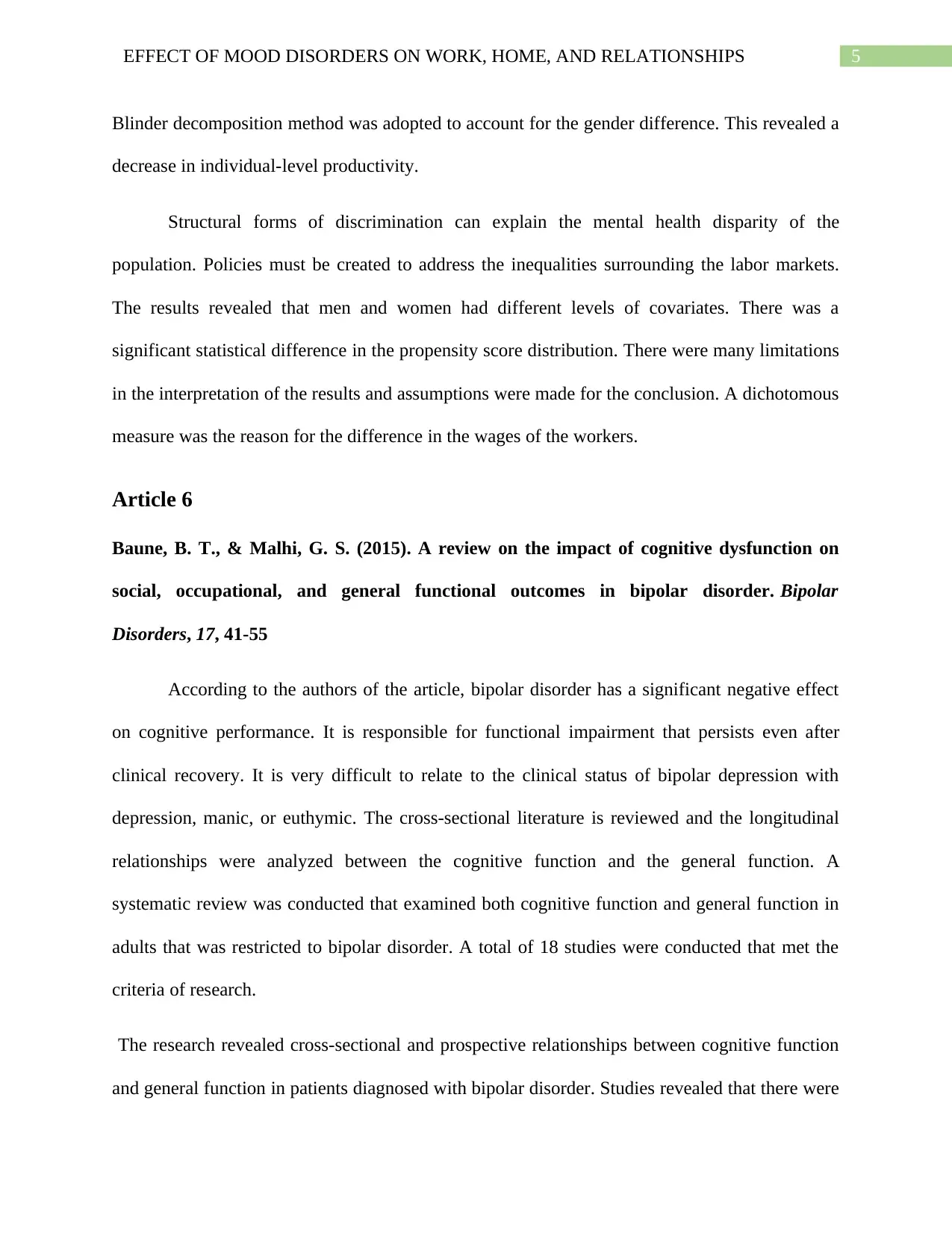
5EFFECT OF MOOD DISORDERS ON WORK, HOME, AND RELATIONSHIPS
Blinder decomposition method was adopted to account for the gender difference. This revealed a
decrease in individual-level productivity.
Structural forms of discrimination can explain the mental health disparity of the
population. Policies must be created to address the inequalities surrounding the labor markets.
The results revealed that men and women had different levels of covariates. There was a
significant statistical difference in the propensity score distribution. There were many limitations
in the interpretation of the results and assumptions were made for the conclusion. A dichotomous
measure was the reason for the difference in the wages of the workers.
Article 6
Baune, B. T., & Malhi, G. S. (2015). A review on the impact of cognitive dysfunction on
social, occupational, and general functional outcomes in bipolar disorder. Bipolar
Disorders, 17, 41-55
According to the authors of the article, bipolar disorder has a significant negative effect
on cognitive performance. It is responsible for functional impairment that persists even after
clinical recovery. It is very difficult to relate to the clinical status of bipolar depression with
depression, manic, or euthymic. The cross-sectional literature is reviewed and the longitudinal
relationships were analyzed between the cognitive function and the general function. A
systematic review was conducted that examined both cognitive function and general function in
adults that was restricted to bipolar disorder. A total of 18 studies were conducted that met the
criteria of research.
The research revealed cross-sectional and prospective relationships between cognitive function
and general function in patients diagnosed with bipolar disorder. Studies revealed that there were
Blinder decomposition method was adopted to account for the gender difference. This revealed a
decrease in individual-level productivity.
Structural forms of discrimination can explain the mental health disparity of the
population. Policies must be created to address the inequalities surrounding the labor markets.
The results revealed that men and women had different levels of covariates. There was a
significant statistical difference in the propensity score distribution. There were many limitations
in the interpretation of the results and assumptions were made for the conclusion. A dichotomous
measure was the reason for the difference in the wages of the workers.
Article 6
Baune, B. T., & Malhi, G. S. (2015). A review on the impact of cognitive dysfunction on
social, occupational, and general functional outcomes in bipolar disorder. Bipolar
Disorders, 17, 41-55
According to the authors of the article, bipolar disorder has a significant negative effect
on cognitive performance. It is responsible for functional impairment that persists even after
clinical recovery. It is very difficult to relate to the clinical status of bipolar depression with
depression, manic, or euthymic. The cross-sectional literature is reviewed and the longitudinal
relationships were analyzed between the cognitive function and the general function. A
systematic review was conducted that examined both cognitive function and general function in
adults that was restricted to bipolar disorder. A total of 18 studies were conducted that met the
criteria of research.
The research revealed cross-sectional and prospective relationships between cognitive function
and general function in patients diagnosed with bipolar disorder. Studies revealed that there were
⊘ This is a preview!⊘
Do you want full access?
Subscribe today to unlock all pages.

Trusted by 1+ million students worldwide

6EFFECT OF MOOD DISORDERS ON WORK, HOME, AND RELATIONSHIPS
more inconsistent associations with cognitive function. There is a consistent relationship between
social and occupational function and cognitive performance. The results revealed that cross-
sectional and prospective relationships between cognitive function and general function in
patients with bipolar disorder in both symptomatic and euthymic patients. A consistent
relationship was established between social and occupational function and cognitive
performance. There were certain limitations in the literature review and the conclusion making
procedure of the study. The functional scales in particular domain-specific measures were also
neglected.
more inconsistent associations with cognitive function. There is a consistent relationship between
social and occupational function and cognitive performance. The results revealed that cross-
sectional and prospective relationships between cognitive function and general function in
patients with bipolar disorder in both symptomatic and euthymic patients. A consistent
relationship was established between social and occupational function and cognitive
performance. There were certain limitations in the literature review and the conclusion making
procedure of the study. The functional scales in particular domain-specific measures were also
neglected.
Paraphrase This Document
Need a fresh take? Get an instant paraphrase of this document with our AI Paraphraser
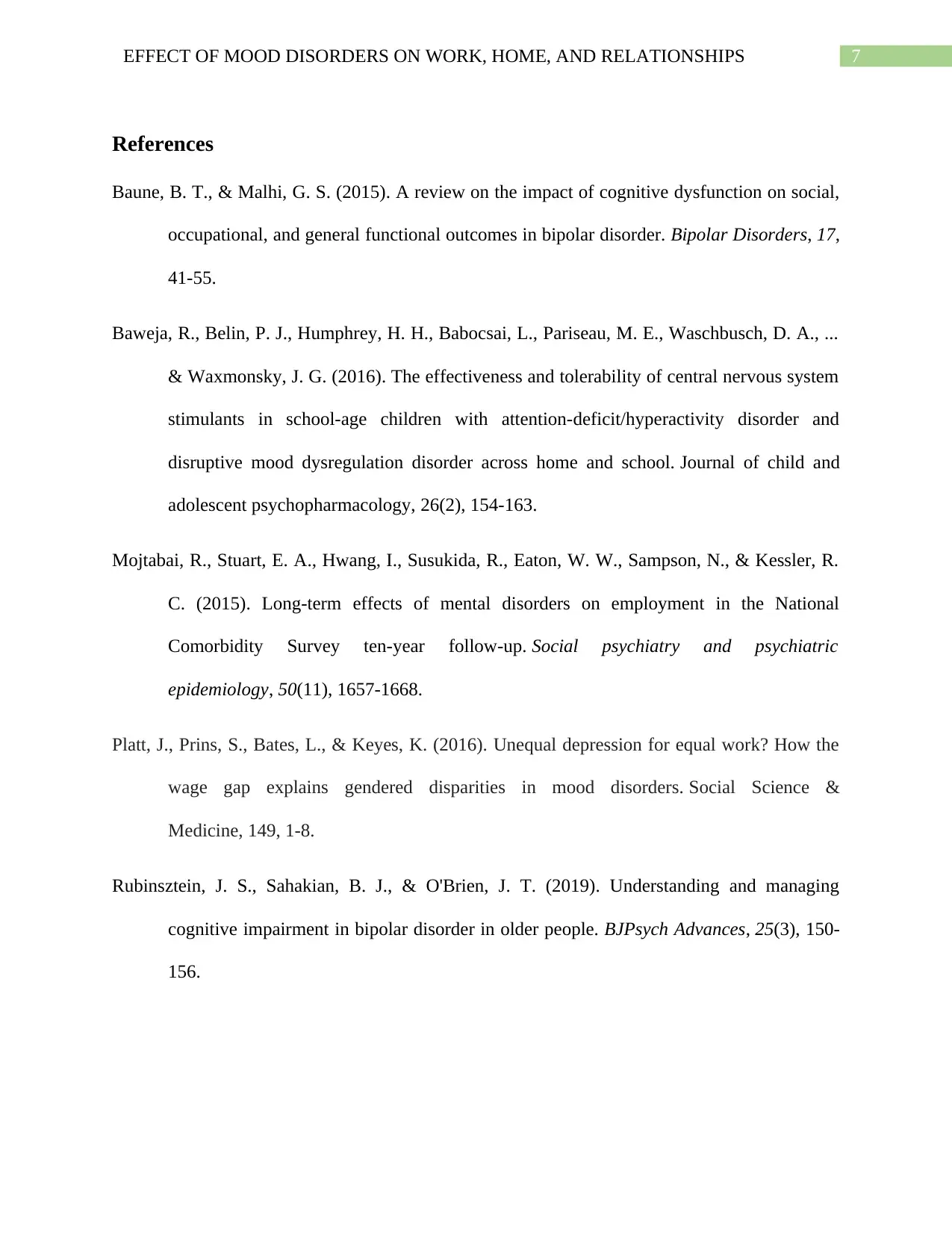
7EFFECT OF MOOD DISORDERS ON WORK, HOME, AND RELATIONSHIPS
References
Baune, B. T., & Malhi, G. S. (2015). A review on the impact of cognitive dysfunction on social,
occupational, and general functional outcomes in bipolar disorder. Bipolar Disorders, 17,
41-55.
Baweja, R., Belin, P. J., Humphrey, H. H., Babocsai, L., Pariseau, M. E., Waschbusch, D. A., ...
& Waxmonsky, J. G. (2016). The effectiveness and tolerability of central nervous system
stimulants in school-age children with attention-deficit/hyperactivity disorder and
disruptive mood dysregulation disorder across home and school. Journal of child and
adolescent psychopharmacology, 26(2), 154-163.
Mojtabai, R., Stuart, E. A., Hwang, I., Susukida, R., Eaton, W. W., Sampson, N., & Kessler, R.
C. (2015). Long-term effects of mental disorders on employment in the National
Comorbidity Survey ten-year follow-up. Social psychiatry and psychiatric
epidemiology, 50(11), 1657-1668.
Platt, J., Prins, S., Bates, L., & Keyes, K. (2016). Unequal depression for equal work? How the
wage gap explains gendered disparities in mood disorders. Social Science &
Medicine, 149, 1-8.
Rubinsztein, J. S., Sahakian, B. J., & O'Brien, J. T. (2019). Understanding and managing
cognitive impairment in bipolar disorder in older people. BJPsych Advances, 25(3), 150-
156.
References
Baune, B. T., & Malhi, G. S. (2015). A review on the impact of cognitive dysfunction on social,
occupational, and general functional outcomes in bipolar disorder. Bipolar Disorders, 17,
41-55.
Baweja, R., Belin, P. J., Humphrey, H. H., Babocsai, L., Pariseau, M. E., Waschbusch, D. A., ...
& Waxmonsky, J. G. (2016). The effectiveness and tolerability of central nervous system
stimulants in school-age children with attention-deficit/hyperactivity disorder and
disruptive mood dysregulation disorder across home and school. Journal of child and
adolescent psychopharmacology, 26(2), 154-163.
Mojtabai, R., Stuart, E. A., Hwang, I., Susukida, R., Eaton, W. W., Sampson, N., & Kessler, R.
C. (2015). Long-term effects of mental disorders on employment in the National
Comorbidity Survey ten-year follow-up. Social psychiatry and psychiatric
epidemiology, 50(11), 1657-1668.
Platt, J., Prins, S., Bates, L., & Keyes, K. (2016). Unequal depression for equal work? How the
wage gap explains gendered disparities in mood disorders. Social Science &
Medicine, 149, 1-8.
Rubinsztein, J. S., Sahakian, B. J., & O'Brien, J. T. (2019). Understanding and managing
cognitive impairment in bipolar disorder in older people. BJPsych Advances, 25(3), 150-
156.
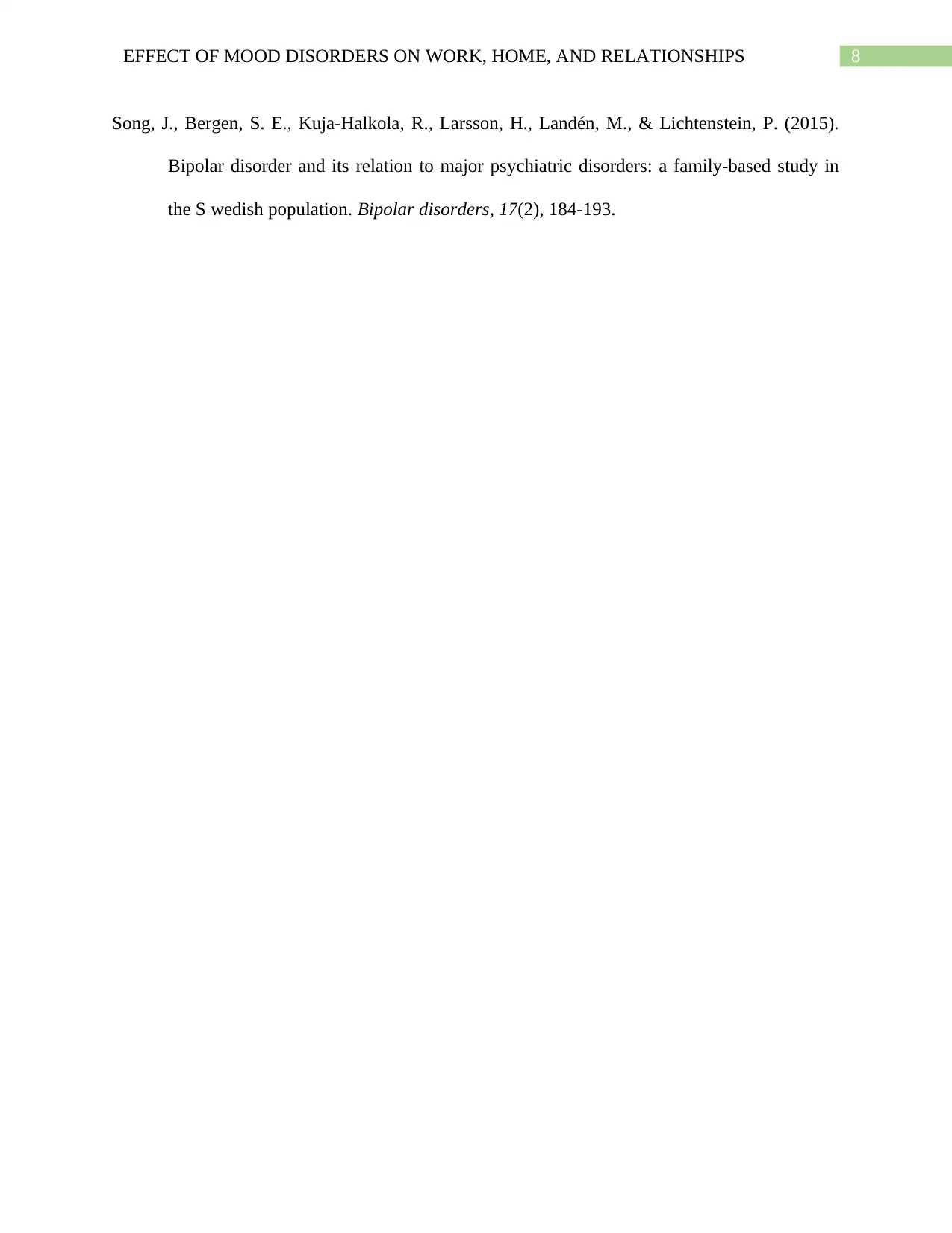
8EFFECT OF MOOD DISORDERS ON WORK, HOME, AND RELATIONSHIPS
Song, J., Bergen, S. E., Kuja‐Halkola, R., Larsson, H., Landén, M., & Lichtenstein, P. (2015).
Bipolar disorder and its relation to major psychiatric disorders: a family‐based study in
the S wedish population. Bipolar disorders, 17(2), 184-193.
Song, J., Bergen, S. E., Kuja‐Halkola, R., Larsson, H., Landén, M., & Lichtenstein, P. (2015).
Bipolar disorder and its relation to major psychiatric disorders: a family‐based study in
the S wedish population. Bipolar disorders, 17(2), 184-193.
⊘ This is a preview!⊘
Do you want full access?
Subscribe today to unlock all pages.

Trusted by 1+ million students worldwide
1 out of 9
Related Documents
Your All-in-One AI-Powered Toolkit for Academic Success.
+13062052269
info@desklib.com
Available 24*7 on WhatsApp / Email
![[object Object]](/_next/static/media/star-bottom.7253800d.svg)
Unlock your academic potential
Copyright © 2020–2025 A2Z Services. All Rights Reserved. Developed and managed by ZUCOL.





